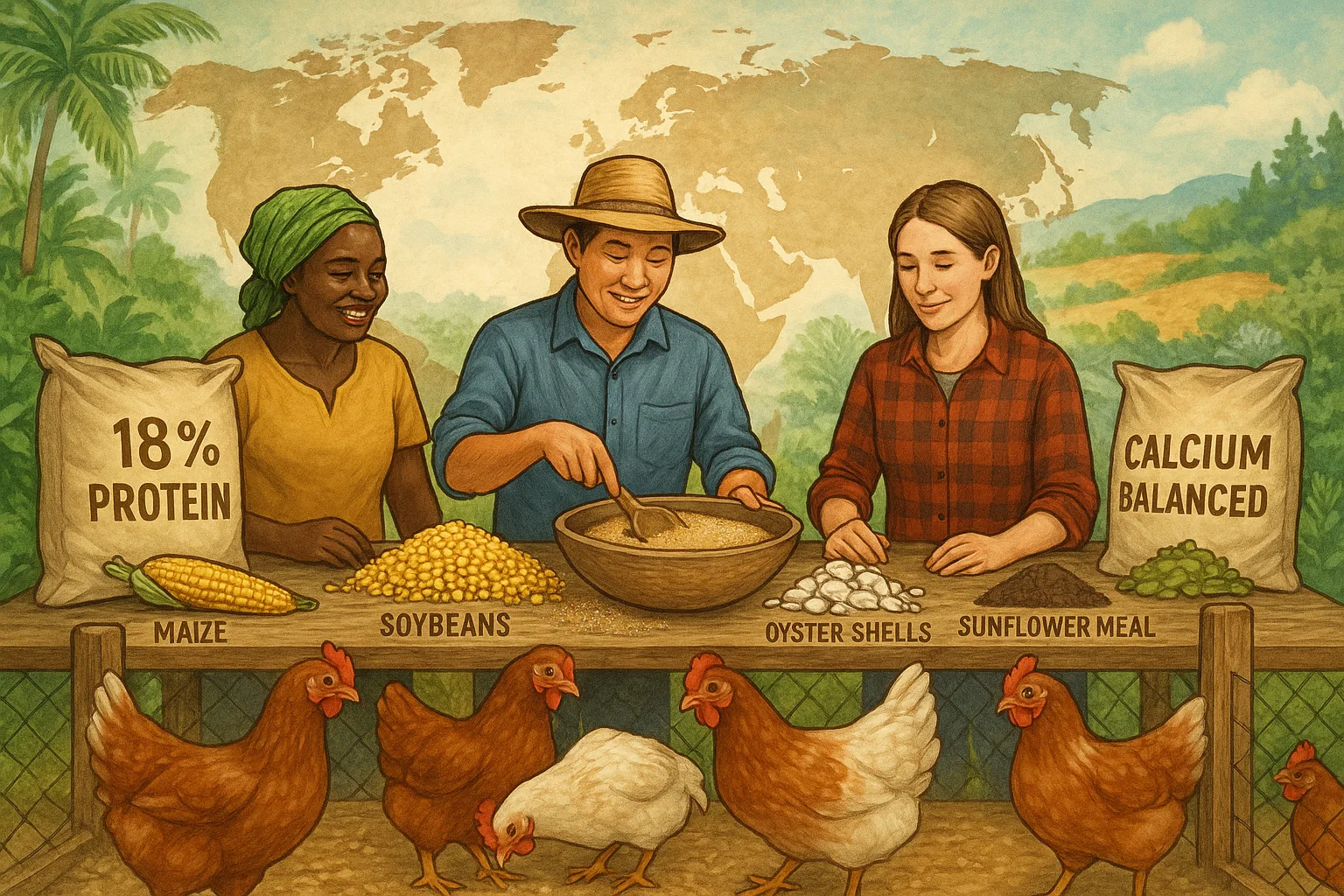The Ultimate Guide to Homemade Chicken Feed: Save 50% and Boost Flock Health

Commercial poultry feed is engineered for scale, not affordability or local adaptability. By switching to homemade rations, small-scale poultry keepers can reduce feed expenses by $400–$900 per year (per 50 hens) and boost egg production by 5–15%, provided the formulations meet nutritional standards.
All content references the NRC Nutrient Requirements of Poultry (1994), FAO technical bulletins, and Poultry Science Journal (Vol. 102, 2023).
1. The Six Core Nutrients Every Chicken Needs
No matter your location, healthy poultry require the same essential nutrients in the right balance:
| Nutrient | Role in Nutrition | Common Sources | Daily Requirement (Layer Hen) |
|---|---|---|---|
| Protein | Muscle and egg formation | Soybean meal, lentils, fishmeal, sunflower meal | 16–18g (0.56–0.63 oz) |
| Calcium | Eggshell strength | Crushed oyster shells, limestone | 4.0–4.5g (0.14–0.16 oz) |
| Phosphorus | Bone and shell development | Bone meal, dicalcium phosphate | 0.4–0.45g (0.014–0.016 oz) |
| Vitamin D3 | Calcium absorption | Sunlight, fish oil, vitamin premix | 300–500 IU |
| Methionine | Feather growth, digestion | Sesame seeds, DL-methionine | 0.35–0.40g (0.012–0.014 oz) |
| Lysine | Muscle development | Soybean, fishmeal, insects | 0.85–1.0g (0.03–0.035 oz) |
Note: Maintain a calcium-to-phosphorus ratio of 2:1. A deviation may result in egg defects, bone weakness, or up to 30% productivity loss (FAO, 2022).
2. Sourcing Ingredients: Regionally Appropriate and Safe
Regional Protein Sources and Safe Inclusion Rates
| Region | Recommended Protein Source | Maximum % in Feed | Processing Required |
|---|---|---|---|
| North America | Pea flour | 20% | None |
| Southeast Asia | Duckweed (sun-dried) | 15% | Sun-dry, protein test suggested |
| East Africa | Sunflower seed cake | 15% | Dehull, solvent-extract |
| Europe | Fava beans | 20% | Soak 12h, rinse |
Universal Feed Safety Warnings
Avoid feeding chickens the following high-risk items:
- Avocado skins and pits – contain persin, a toxic compound
- Raw or undercooked beans – high in phytohemagglutinin, toxic in small amounts
- Moldy grains – may contain aflatoxins or ochratoxins, which damage liver and kidneys
3. Feed Formulation Using Pearson Square Method
The Pearson Square is a basic tool for calculating correct ratios when mixing two feed ingredients to reach a target protein level.
Example: Target 18% protein using maize (8%) and soybean meal (45%)
Step 1: Soybean Difference = 18 - 8 = 10
Step 2: Maize Difference = 45 - 18 = 27
Step 3: Total Parts = 10 + 27 = 37
Soybean = (10 ÷ 37) × 100 = 27%
Maize = (27 ÷ 37) × 100 = 73%
For a 50kg (110 lb) batch:
- Soybean meal: 13.5kg (30 lb)
- Maize: 36.5kg (80 lb)
- Add: 0.5kg limestone, 0.3kg dicalcium phosphate, 100g salt
Note: This method only works for two-ingredient mixes. For complex formulations, use the free feed formulation calculator.
4. Climate-Responsive Feed Recipes
Layer Feed for Hot/Humid Climates
(50kg / 110 lb batch)
| Ingredient | Metric | Imperial | Function |
|---|---|---|---|
| Maize | 25kg | 55 lb | Energy source |
| Soybean meal | 12kg | 26.5 lb | Protein source |
| Dried duckweed | 5kg | 11 lb | Protein, moisture aid |
| Oyster shell | 5kg | 11 lb | Calcium |
| Salt | 150g | 5.3 oz | Electrolyte balance |
| Vitamin premix | 200g | 7 oz | Vitamins, minerals |
Nutrient Profile: ~17% protein, 3.8% calcium, 0.4% phosphorus
Broiler Starter Feed for Cold Climates
(50kg / 110 lb batch)
| Ingredient | Metric | Imperial |
|---|---|---|
| Barley | 25kg | 55 lb |
| Pea flour | 12kg | 26.5 lb |
| Fishmeal | 8kg | 17.6 lb |
| Beef tallow | 1.5kg | 3.3 lb |
| Vitamin premix | 200g | 7 oz |
Cold climate tip: Increase fat to 6–7% if ambient temperatures fall below -10°C (14°F).
5. Processing & Feed Safety
Fermented Feed: Improved Digestion and Absorption
- Mix 1kg dry feed with 1.4L water and 2 tablespoons vinegar or kefir
- Allow to ferment 24–48 hours at 20–30°C (68–86°F)
- Stir daily
- Use within 72 hours; discard if pH >4.5 or mold appears
Result: Nutrient absorption increases by 25–40%, and digestion improves
Mycotoxin Risk Management
- UV light detects some aflatoxins, but lab testing is more reliable
- In humid or tropical climates, send feed samples for testing at least quarterly
- Cost of testing: $15–$30 per sample
6. Non-Negotiable Safety Protocols
- Animal by-products must be heat-treated at 65°C (150°F) for 30 minutes to eliminate salmonella
- Anti-nutrient reduction techniques:
- Soak legumes in 1% wood ash solution or limewater for 12 hours, then rinse
- Toast grains at 120°C (250°F) for 10 minutes to deactivate enzyme inhibitors
- Storage guidelines:
- Airtight containers below 15°C (59°F)
- Fermented mash: up to 7 days
- Dry mash: 1 month
- Pellets: up to 3 months
7. Cost Analysis: Realistic Savings Over Time
(Based on 50 laying hens over 12 months)
| Cost Item | Commercial Feed | Homemade Feed |
|---|---|---|
| Annual Feed Cost | $1,500–$1,800 | $600–$900 |
| Equipment Setup* | — | $200–$400 |
| Net Year 1 Savings | — | $300–$800 |
*Initial equipment includes a grinder, weighing scale, and sealed storage bins.
Cost Assumptions:
- Homemade feed: $0.25–0.40/kg
- Commercial feed: $0.60–1.00/kg
Money-saving tip: Use brewery grain waste, cassava peels, or amaranth leaf meal to cut feed costs by another 10–30% depending on region.
8. Climate Adaptation Strategies
Tailoring your feed system to environmental stressors is key to resilience.
| Climate Challenge | Recommended Solution | Suitable Regions |
|---|---|---|
| Drought | Replace 20% grain with cactus pads | Mexico, Kenya, Brazil |
| Floods | Incorporate pond-grown duckweed | Southeast Asia |
| Heat stress | Add 0.5% baking soda to water | Australia, India |
| Sub-freezing temps | Increase whole grains to 70% of diet | Canada, Russia |
Expert Insight:
“Local ingredients beat imported pellets when correctly balanced.”
— Dr. Emma Naluyima, UN Livestock Advisor
Disclaimer: Homemade feed must be properly balanced and, where possible, verified by lab testing. Consult a poultry nutritionist if flock performance drops.
